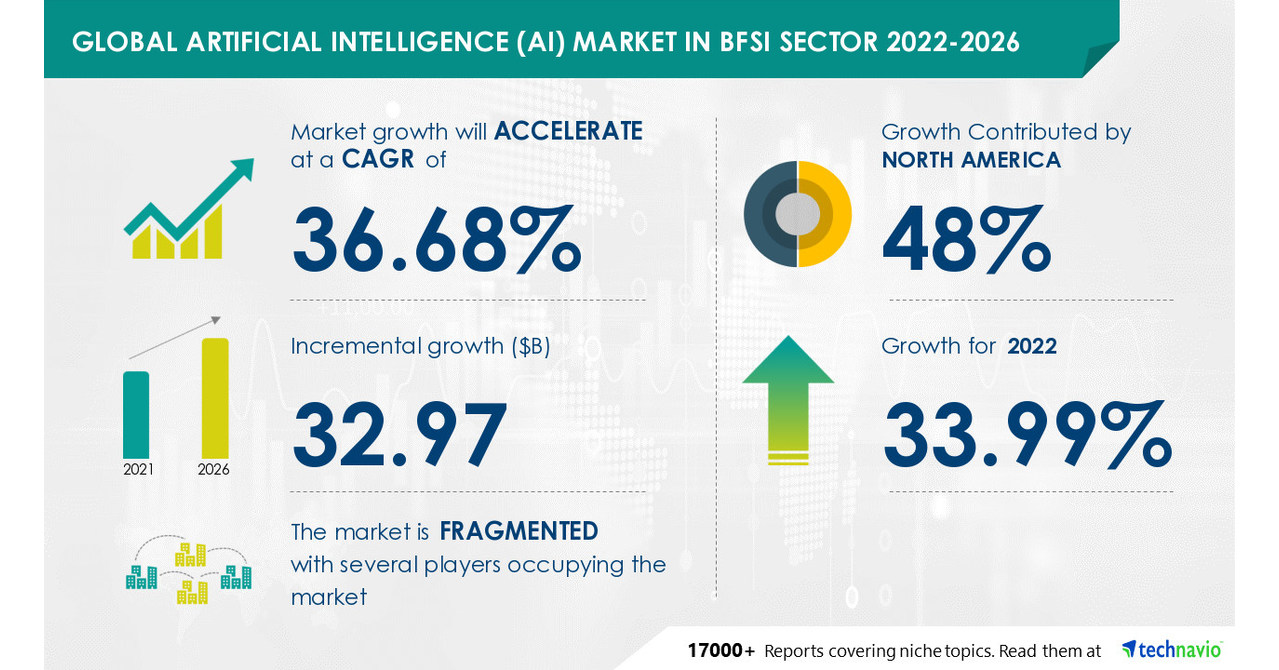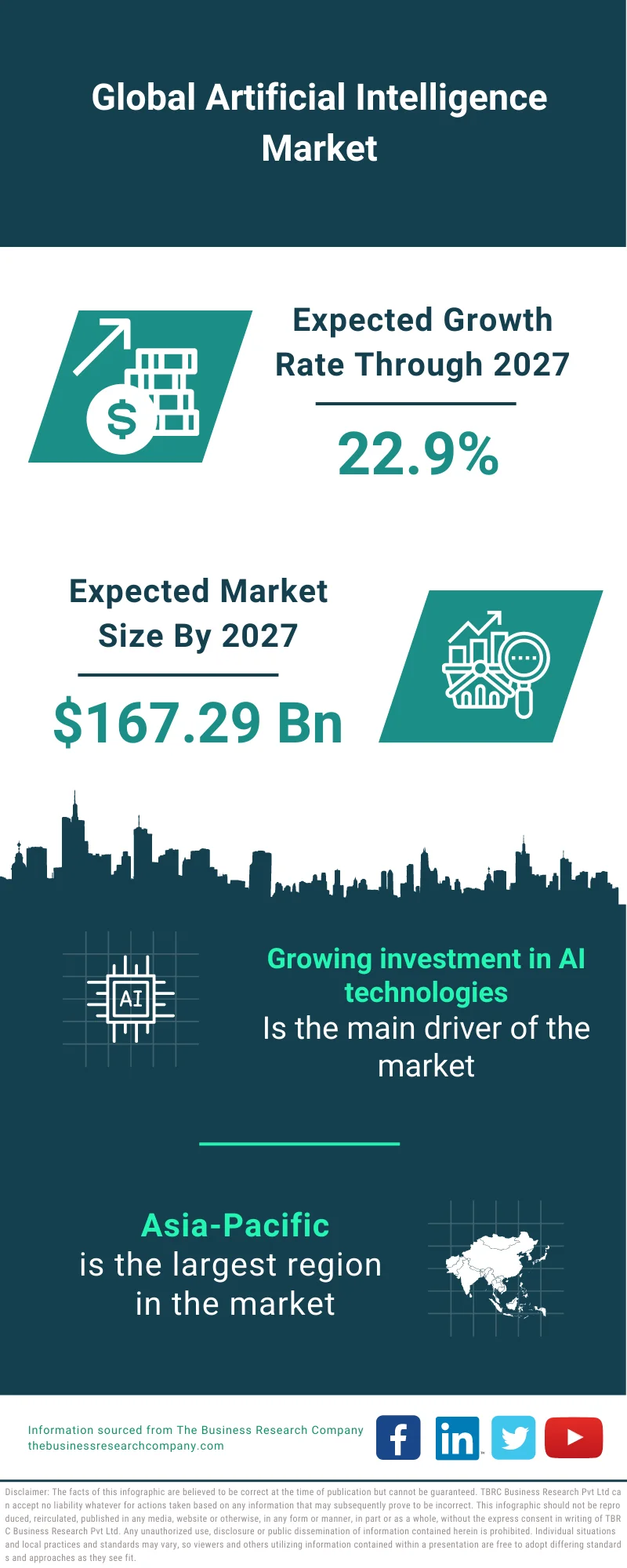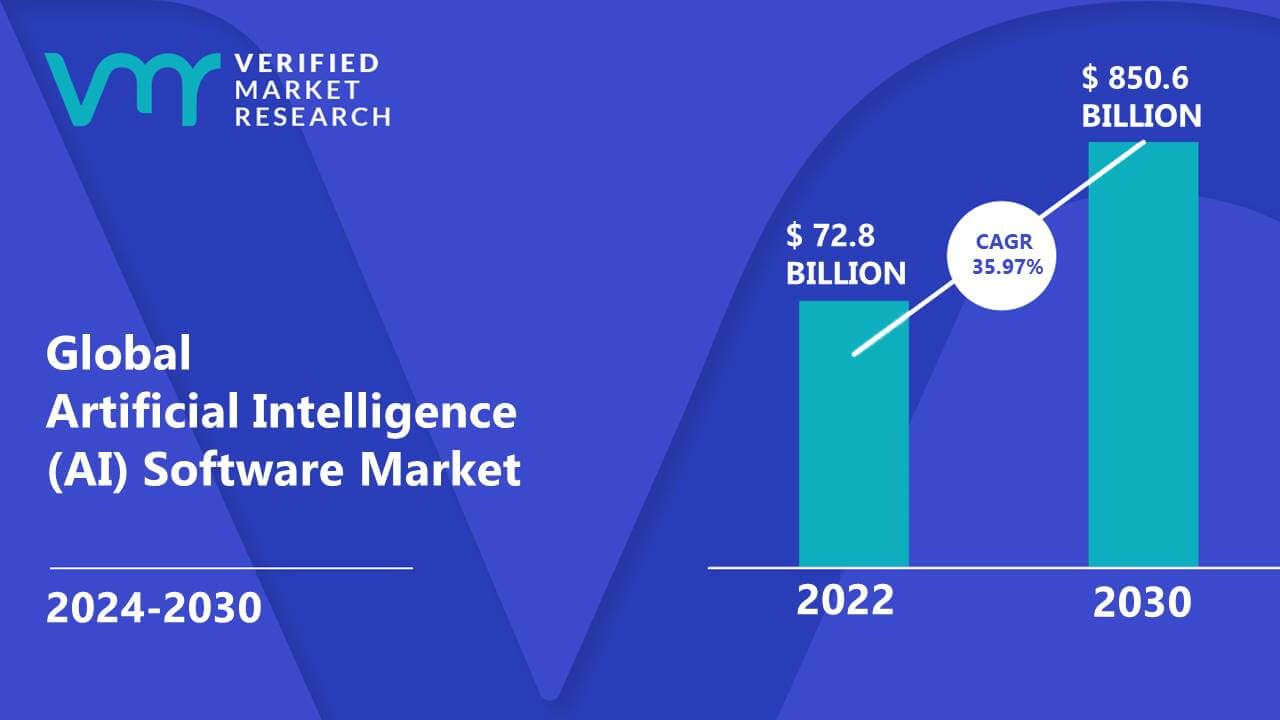
Content generated by MindOS.
MindOS may produce inaccurate information about people, places, or facts.

Content generated by MindOS.
MindOS may produce inaccurate information about people, places, or facts.
Here are four high-quality, visualized, and infographic tables related to the AI industry:
Artificial Intelligence (AI) Market in BFSI Sector to Record USD ...
Source: Technavio

Artificial Intelligence Market Size, Trends and Global Forecast To ...
Source: The Business Research Company

Artificial Intelligence (AI) Software Market Size, Share & Forecast
Source: Verified Market Research

AI Text Generator Market Size, Share, Analysis | Forecast 2032
Source: Market.us

Please note that these tables provide valuable insights into the AI industry and its market share.
The artificial intelligence (AI) industry has experienced significant growth and is expected to continue expanding in the coming years. AI technology has become increasingly integrated into various sectors, revolutionizing the way businesses operate and creating new opportunities for innovation. This section provides an overview of the AI industry, including market size, investment trends, and key considerations.
The global artificial intelligence market size was valued at $X million in 2021, and it is projected to reach $X million by 2030 1. This rapid growth can be attributed to the increasing adoption of AI technologies across industries and the growing demand for automation and intelligent decision-making systems. AI is being utilized in various applications, such as healthcare, finance, retail, and manufacturing, to enhance efficiency, productivity, and customer experience.
Private investment in AI has been on the rise, with significant funding being directed towards AI startups and research and development activities. In 2022, the global private investment in AI reached $X billion, with investments distributed across different industries 2. This highlights the growing interest and confidence in AI as a transformative technology. Industries such as healthcare, finance, and technology are leading in AI investment, leveraging its potential to drive innovation and gain a competitive edge.
While AI offers immense opportunities, organizations need to address various challenges and considerations when adopting AI technologies. Risks associated with AI, such as data privacy, bias, and ethical concerns, need to be mitigated to ensure responsible and accountable AI deployment 3. Organizations are increasingly taking steps to reduce AI carbon emissions and incorporate sustainability efforts into their AI strategies [^7^]. Additionally, addressing gender balance in AI development and deployment is crucial to ensure fair and inclusive AI systems 4.
Overall, the AI industry presents significant potential for growth and innovation. However, it is essential for organizations to navigate the challenges and considerations associated with AI adoption to maximize its benefits and minimize risks.
[Login]:
[Log in]:
[Statista Account]:
[Business Solutions]:
[Immediate access to statistics, forecasts & reports]:
[Usage and publication rights]:
[Download in various formats]:
[Basic Account]:
[Instant access to 1m statistics]:
[Download in XLS, PDF & PNG format]:
[Detailed references]:
[Starter Account]:
[Ideal entry-level account for individual users]:
[Professional Account]:
[Full access]:
[Prices do not include sales tax]:
The global artificial intelligence (AI) industry is set to revolutionize the productivity and GDP potential of the global economy. According to PwC's Global Artificial Intelligence Study, AI has the potential to contribute up to $15.7 trillion to the global economy by 2030, surpassing the current output of China and India combined. This forecast highlights the immense value potential of AI and its impact on various sectors and economies worldwide.
AI is expected to contribute $15.7 trillion to the global economy by 2030. This figure represents the combined value of increased productivity and consumption-side effects driven by AI technologies. The potential economic impact of AI is significant and presents a game-changing opportunity for businesses worldwide.
By 2030, AI is projected to boost GDP for local economies by up to 26%. This boost in GDP is driven by the adoption of AI technologies that augment labor productivity and automate certain tasks and roles. The integration of AI into various industries will lead to increased efficiency and economic growth.
PwC has identified and rated approximately 300 AI use cases, which are captured in the AI Impact Index. This index provides insights into the potential impact of AI across different sectors and helps businesses target their investments in the short- to medium-term. The AI Impact scores range from 1 to 5, with 5 indicating the highest impact.
High Potential Use Case: Data-based Diagnostic Support
AI-powered diagnostics have the potential to revolutionize healthcare by using patient data to identify possible health conditions in need of further investigation and treatment. AI can augment physician diagnoses and continuously learn from interactions with healthcare professionals, leading to improved accuracy and autonomous operation in the future. However, concerns over privacy and data protection need to be addressed, and technological advancements are necessary for the full potential of AI in healthcare to be realized.
High Potential Use Case: Autonomous Fleets for Ride Sharing
Autonomous fleets can enable on-demand access to vehicles, reducing the need for personal car ownership and increasing asset utilization. However, the development of technology that ensures safe operation under extreme weather conditions and gaining consumer trust and regulatory acceptance are barriers that need to be overcome for the widespread adoption of autonomous fleets.
High Potential Use Case: Personalized Financial Planning
AI-powered robo-advice has made personalized financial planning accessible to mass-market consumers. AI can dynamically manage finances to match goals and optimize available funds, making customized investment solutions more accessible. However, increasing customer acceptance and regulatory acceptance are crucial for realizing the full potential of AI in personalized financial planning.
High Potential Use Case: Personalized Design and Production
AI can enable tailored, on-demand production of apparels and consumables, leading to increased customization and agility in the retail industry. Design and production processes
The field of generative artificial intelligence (AI) is rapidly evolving and becoming increasingly crowded, with many companies and research institutions investing heavily in this cutting-edge technology. Generative AI aims to produce new and original content for various applications, such as image and video creation, natural language processing, and music composition.
Several key players dominate the generative AI space, each offering different approaches and solutions. Some of the most prominent companies in this field include:
OpenAI: OpenAI is one of the leading companies in generative AI. They have developed advanced language models like GPT-3.5, which can generate coherent and grammatically correct sentences and paragraphs. OpenAI has also created other generative models like DALL-E and Codex.
Microsoft: Microsoft has made significant advancements in generative AI, including the integration of OpenAI's ChatGPT into its search engine, Bing. While this caused a stir in the market, Bing is not currently posing a serious threat to Google's dominance.
Google: Google has been at the forefront of generative AI research and development. They have developed models like BERT and GPT based on the Transformer model, which revolutionized natural language processing tasks. Google's search engine has a competitive advantage over Bing in terms of responding to user search requests and inferring user intent.
Meta Platforms: Meta Platforms (formerly Facebook) has been making strides in AI algorithms, particularly in neuro-symbolic AI. Their Cicero algorithm combines deep learning and rules-based software for reasoning. This approach may be better suited for solving complex problems.
IBM: IBM is another major player in generative AI, investing in research and development in this area. They have contributed to the advancements in machine learning frameworks like generative adversarial networks (GANs), which are crucial for generative AI.
China's Tech Giants: Chinese companies like Baidu, Alibaba, and Tencent have also joined the generative AI trend. Baidu, for example, plans to release its own version of ChatGPT called Ernie Bot. These companies have a significant presence in the Chinese market and are investing in developing their generative AI models.
Generative AI systems based on large language models (LLMs), like OpenAI's ChatGPT, have been in development for several years. Technological advancements, such as the introduction of generative adversarial networks (GANs) by Ian Goodfellow in 2014, have accelerated the progress in generative AI. GANs consist of generative and discriminative networks that compete with each other, enabling the model to learn in an unsupervised manner.
The Transformer model, developed by Google Brain researchers in 2017, has also played a significant role in advancing generative AI. The Transformer model improves on recurrent neural networks (RNNs) by processing entire inputs of data
The AI industry is rapidly advancing and has the potential to bring about significant benefits to various sectors. However, there are also several risks associated with the development and deployment of artificial intelligence. This section of the industry report explores some of the key risks in the AI industry.
AI has the potential to automate various jobs, leading to concerns about job displacement. The legal field, for example, could see a significant shakeup as AI algorithms are developed to handle complex contracts. This could replace a significant number of corporate attorneys who currently spend extensive time reading through large volumes of data and documents. The risk lies in the possibility of AI algorithms missing critical information or making errors in contract structures, which could have legal and financial consequences.
The rise of social media platforms and AI algorithms has enabled social manipulation and the spread of misinformation. Politicians, for instance, can leverage AI algorithms on platforms like TikTok to promote their viewpoints and capture the votes of specific demographics. The risk lies in the algorithm's failure to filter out harmful and inaccurate content, leading to the dissemination of dangerous and misleading media. Additionally, the emergence of deepfake technology further blurs the line between credible and faulty news, making it challenging to discern what is real and what is not.
AI technology, such as facial recognition, has been used for social surveillance purposes in some countries. For example, China has implemented facial recognition technology in various venues, allowing the government to monitor individuals' activities, relationships, and even political views. This raises concerns about privacy and security, as well as potential abuses of power. Similarly, predictive policing algorithms used by U.S. police departments can disproportionately impact certain communities, leading to over-policing and questions about the potential for AI to become an authoritarian weapon.
AI algorithms can be biased, reflecting the biases of their human creators. This bias can go beyond gender and race, impacting various aspects of AI applications. Biases in data and algorithms can lead to discriminatory hiring practices, inaccuracies in speech recognition AI, and the impersonation of notorious figures by chatbots. The risk lies in perpetuating existing biases and prejudices, putting minority populations at risk and undermining diversity, equity, and inclusion efforts.
The adoption of AI technology can widen socioeconomic inequality. Blue-collar workers performing manual and repetitive tasks may experience significant wage declines due to automation, while white-collar workers remain largely unaffected or even benefit from AI advancements. This class bias in AI application raises concerns about fairness and social justice. The risk lies in exacerbating existing inequalities and creating a more divided society.
AI technology can weaken ethics and goodwill in various ways. The misuse of AI tools, such as ChatGPT, for academic dishonesty threatens academic
The global artificial intelligence (AI) industry has been rapidly growing, transforming various sectors and driving innovation. However, this industry is not without its challenges. In this section, we will explore the key challenges faced by the global AI industry based on the information provided in the article "The Artificial Intelligence Industry and Global Challenges" by Forbes.
One of the primary challenges in the global AI industry is the ethical considerations surrounding the use of AI technology. As AI becomes more advanced and integrated into various aspects of society, there is a growing concern about the ethical implications of its deployment. The article highlights the need for AI systems to be designed and utilized in a manner that aligns with ethical standards, ensuring transparency, fairness, and accountability.
Another significant challenge is the presence of bias in AI systems. The article emphasizes the importance of addressing biases that may exist in training data or algorithms, which can lead to discriminatory outcomes. Bias can arise from various sources, including data collection methods, algorithmic design, or unintentional human biases. It is crucial for the AI industry to actively work towards developing unbiased AI systems to ensure fairness and prevent discrimination.
The global AI industry faces challenges related to data privacy and security. With the increasing reliance on AI systems, vast amounts of personal data are collected, processed, and analyzed. Safeguarding this data and ensuring privacy protection is of paramount importance. The article highlights the need for robust data protection regulations and frameworks to be in place to address these concerns and maintain public trust.
Additionally, the AI industry must address cybersecurity risks associated with AI systems. The interconnected nature of AI technologies makes them vulnerable to cyber threats, including data breaches, hacking, and malicious attacks. The industry needs to develop robust security measures to protect AI systems and prevent unauthorized access or manipulation of data. Collaborative efforts between AI developers, cybersecurity experts, and policymakers are crucial to mitigate these risks effectively.
A significant challenge faced by the global AI industry is the shortage of skilled professionals in the field. The rapid growth of AI has created a demand for experts in areas such as machine learning, data science, and AI ethics. However, there is a limited supply of individuals with the necessary skills and knowledge to meet this demand. Addressing this shortage requires investment in education and training programs to develop a skilled workforce capable of driving AI innovation.
Furthermore, the dynamic nature of the AI industry necessitates continuous learning and adaptability. AI technologies evolve rapidly, and professionals in the field must stay updated with the latest advancements and trends